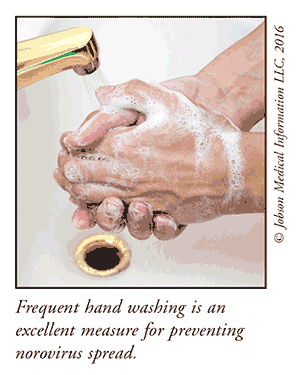US Pharm. 2017;41(4):13-14.
Common Infection That Causes Gastroenteritis
Quite contagious and found in most areas of the world, norovirus is one of the most common sources of gastroenteritis, an irritation of the stomach and intestines that often results in abdominal pain, nausea, vomiting, and diarrhea. Norovirus, discovered in the 1970s, is sometimes known as winter vomiting disease because it is so common during the winter months. It is hard to control outbreaks since norovirus can be transmitted person-to-person as well as through contaminated food and drink. Isolated environments such as daycare centers, schools, nursing homes, and cruise ships are high-risk sites for norovirus outbreaks.
The Elderly and Young Children Are More Susceptible
Contracting Norovirus
Norovirus is the name used to describe a group of similar viruses, previously known as Norwalk-like viruses. These viruses only infect humans, not animals, and can live in food, water, and on surfaces such as tables and doorknobs.

Coughing and sneezing by infected people can spread the virus through the air. Eating contaminated food or coming into contact with a contaminated water source can also spread norovirus infection. In fact, food poisoning from norovirus is sometimes mistaken for Salmonella poisoning at first. Foods that often harbor norovirus include raw oysters, salads, and uncooked fruits. Even fully cooked foods handled by an infected person can spread norovirus. The virus can also spread between people via body fluids like vomit and feces.
There are certain groups more prone to norovirus infection. These groups include those with weakened immune systems, including the elderly, young children, some organ-transplant patients, people with immune diseases such as AIDS, and those undergoing chemotherapy. Naturally, healthcare workers are at higher risk of contracting norovirus because they are more frequently exposed to sick patients. People who work in enclosed environments with other people, like flight attendants, are more likely to become infected.
Symptoms and Treatment
The typical symptoms of norovirus infection are fatigue, nausea, vomiting, headache, muscle pain, diarrhea, and a low-grade fever. Symptoms appear 1 to 2 days after contracting the virus and usually last from 12 hours to 2 days. Norovirus infection typically leaves its victims tired and dehydrated, but serious complications are rare. However, there are about 800 deaths from norovirus each year, usually among very young children and the elderly.
Currently, treatment focuses on reducing symptoms like nausea and muscle aches, rather than attacking the virus itself. In a healthy person, the infection simply runs its course. Nonprescription products such as acetaminophen (Tylenol) or ibuprofen can help relieve aches and fever. Oral rehydration solutions that replace water and electrolytes lost due to vomiting and diarrhea can prevent dehydration.
There is currently no vaccine for norovirus, although efforts to develop one are underway. Antibiotics are typically not effective against viral illnesses, but there may be a unique situation with norovirus. Research has suggested that norovirus infections may have a “helper” bacteria present in the gut. Laboratory studies have shown a reduction in norovirus when these bacteria are killed by antibiotics.
Prevention Is the Best Medicine
There are some basic precautions that can significantly reduce the chance of contracting norovirus. Avoiding raw or undercooked foods and making certain that food workers follow sanitary procedures and use gloves go a long way toward preventing the spread of norovirus. Additionally, frequent hand washing is an excellent preventative measure for everyone.
Young children, the elderly, and those with weak immune systems should avoid sick people. Take barrier precautions—such as wearing gloves, protecting the eyes from body fluids, and covering the nose and mouth with a mask—when caring for someone suffering from norovirus to reduce the spread of the infection. These measures will help to lower the rate of transmission.
Your local pharmacist is here to help! If you, a friend, or a family member have questions about prevention or management of norovirus infection, ask a trusted pharmacist or other healthcare provider.
To comment on this article, contact rdavidson@uspharmacist.com.





